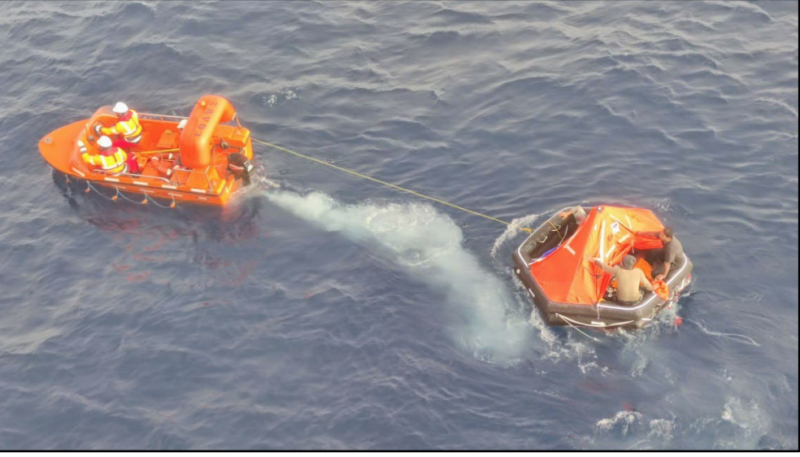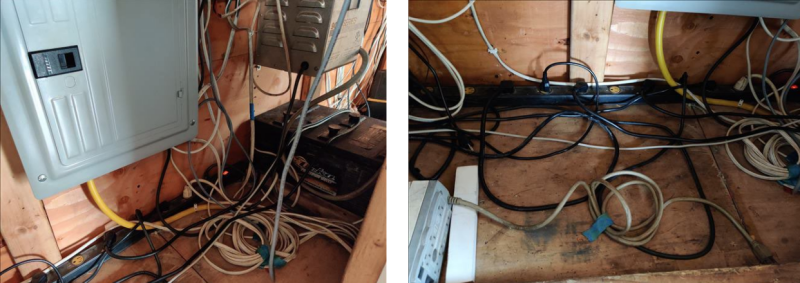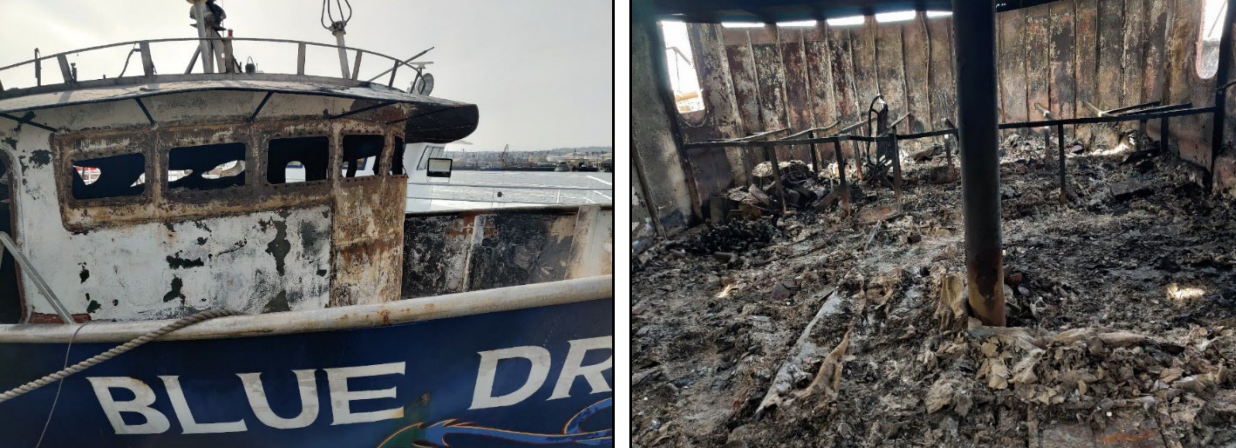An electrical fault likely triggered a wheelhouse fire that doomed the Hawaii-based longliner Blue Dragon in November 2021, according to a new report from the National Transportation Safety Board.
The agency’s findings stress two major “lessons learned” from the Blue Dragon case: The danger of substandard electrical systems, and the value of personal locator beacons (PLBs) as a safety supplement to emergency position indicating radio beacons (EPIRBs).
Both types of beacons played a critical role in the survival and speedy rescue of the Blue Dragon crew after the fire cut off their wheelhouse communications and knocked out vessel power, the report notes.
The 85-foot steel vessel departed Honolulu Oct. 25 with a crew of six and a National Marine Fisheries Service observer, to fish for swordfish and tuna. At around 11:30 p.m. Nov. 9 the crew was preparing to retrieve the gear about 350 miles off the coast of California, as the owner-captain napped in the wheelhouse, according to the NTSB report narrative.
The observer entered the wheelhouse, discovered a fire burning under the controls console and woke the captain. The observer discharged a dry chemical fire extinguisher into the fire, alerted the crew, and a deckhand arrived with another fire extinguisher.
“The deckhand described the forward bulkhead as being on fire all the way to the overhead of the wheelhouse,” the NTSB report states. “When the remaining crew came to assist, they opened the wheelhouse doors, which, according to the NMFS observer, appeared to fan the flames. While the crew was attempting to fight the fire, the NMFS observer and a deckhand retrieved the 10-person life raft and the vessel’s GNSS-enabled EPIRB from above the wheelhouse. They carried the life raft aft to the vessel’s stern and deployed it into the water.”
The observer went to his berth to retrieve a bag with his NMFS-issued survival suit, EPIRB, PLB, and satellite emergency notification device (SEND), a Garmin inReach. He used the SOS button on the Garmin and texted a “fire” message, manually activated the Blue Dragon’s EPIRB and his own PLB.
After fighting the fire for about 10 minutes with extinguishers and the deck washdown hose, the crew and observer were forced back by heavy smoke and could not reach the wheelhouse radios. The Blue Dragon’s power went out and the captain and crew decided to abandon the vessel into the life raft secured by a painter.
Alerts from the emergency locator devices began coming into Garmin’s International Emergency Response Coordination Center and the Coast Guard Rescue Coordination Center in Alameda, Calif. The Garmin center contacted the Coast Guard with the observer’s SEND text information – the first indication there was a fire.
Using the Coast Guard Automated Mutual-Assistance Vessel Rescue System (AMVER), the Alameda command center issued a request for assistance from other vessels in the area. The crew of the 623-foot Portugal-flagged bulk carrier NordRubicon, en route from Vietnam and located 80 miles northwest of the beacons’ location, responded and told watchstanders they could divert at 2:25 a.m. and assist the fishing crew.
A Coast Guard C-27J Spartan surveillance aircraft arrived on scene at 3:21 a.m. and identified the crew in the life raft. The aircrew dropped supplies, a datum marker buoy, and additional life rafts to the crew. The crew stayed in their raft tethered to the Blue Dragon until daylight, when they reboarded the vessel with the vessel’s EPIRB and extinguished the remaining fire with buckets of sea water. The NMFS observer activated his NMFS-issued EPIRB.
The NordRubicon arrived around 9 a.m., and by 11:35 a.m. had brought the survivors on board to continue on to California.

The Blue Dragon drifted until Nov. 12, when the captain’s other vessel Blue Dragon II towed the hulk to San Pedro, Calif. There, investigators visited both the Blue Dragon and Blue Dragon II.
“The Blue Dragon’s wooden wheelhouse console had held two laptops used for navigation and a flat screen monitor used as a television. The wheelhouse deck was raised a few feet above the main deck, and beneath this ‘false deck’ was a void space,” the report states.
“According to the captain of the Blue Dragon, there was nothing stowed under the wheelhouse console, and he believed the cause of the fire was electrical. A deckhand told investigators that he was aware of computer equipment and possibly batteries stowed under the console. There was no smoke detector installed in the wheelhouse.
“Under the Blue Dragon II’s console, investigators found wiring that did not meet typical marine standards – there were bare wires, improper connections, and loose and disorganized wiring.”
The Blue Dragon had its last Coast Guard commercial fishing vessel safety examination in June 2020, and deficiencies were corrected for the bilge pump and lack of alcohol testing kits, according to the NTSB. During a random Coast Guard boarding at Honolulu in April 2021, no deficiencies were issued.
The NTSB found “that the probable cause of the fire aboard the fishing vessel Blue Dragon was from an unknown source, likely electrical in nature, which ignited the wooden wheelhouse console. Contributing to the extent of the fire damage was the substantial use of combustible materials in the joinery, outfitting, and furnishings in the wheelhouse and accommodation spaces.”
The agency stressed two major lessons from the Blue Dragon.
- “Substandard electrical installation and outfitting – including bare wires, unsecured wire nuts, overloaded circuits, loose wiring, and household wiring not designed for marine use – is a common cause of shipboard/vessel electrical fires. Additionally, batteries have been identified as ignition sources of fires in multiple modes of transportation. Vessel operators should ensure electrical systems are adequately designed, installed, and maintained in accordance with established marine standards to prevent fires.”
- “Personal locator beacons helped validate the position of the vessel’s emergency position indicating radio beacon, and a SEND helped responders identify the nature of the emergency. Vessel owners and operators can enhance the safety of their crews by equipping their vessels and crews with these additional satellite technologies to supplement EPIRBs.”
Personal locator beacons are a longstanding priority recommendation from the NTSB. Following its investigation of the 2015 sinking of the cargo vessel El Faro, with the loss of all 33 crew members, the agency urged the Coast Guard to make PLBs mandatory safety equipment. That recommendation was reiterated after the 2019 sinking of the fishing vessel Scandies Rose off Alaska, with the loss of five crew members.
The NTSB “concluded that personal locator beacons would aid in search and rescue operations by providing continuously updated and correct coordinates of crewmembers’ locations. The recommendation remains open.”








